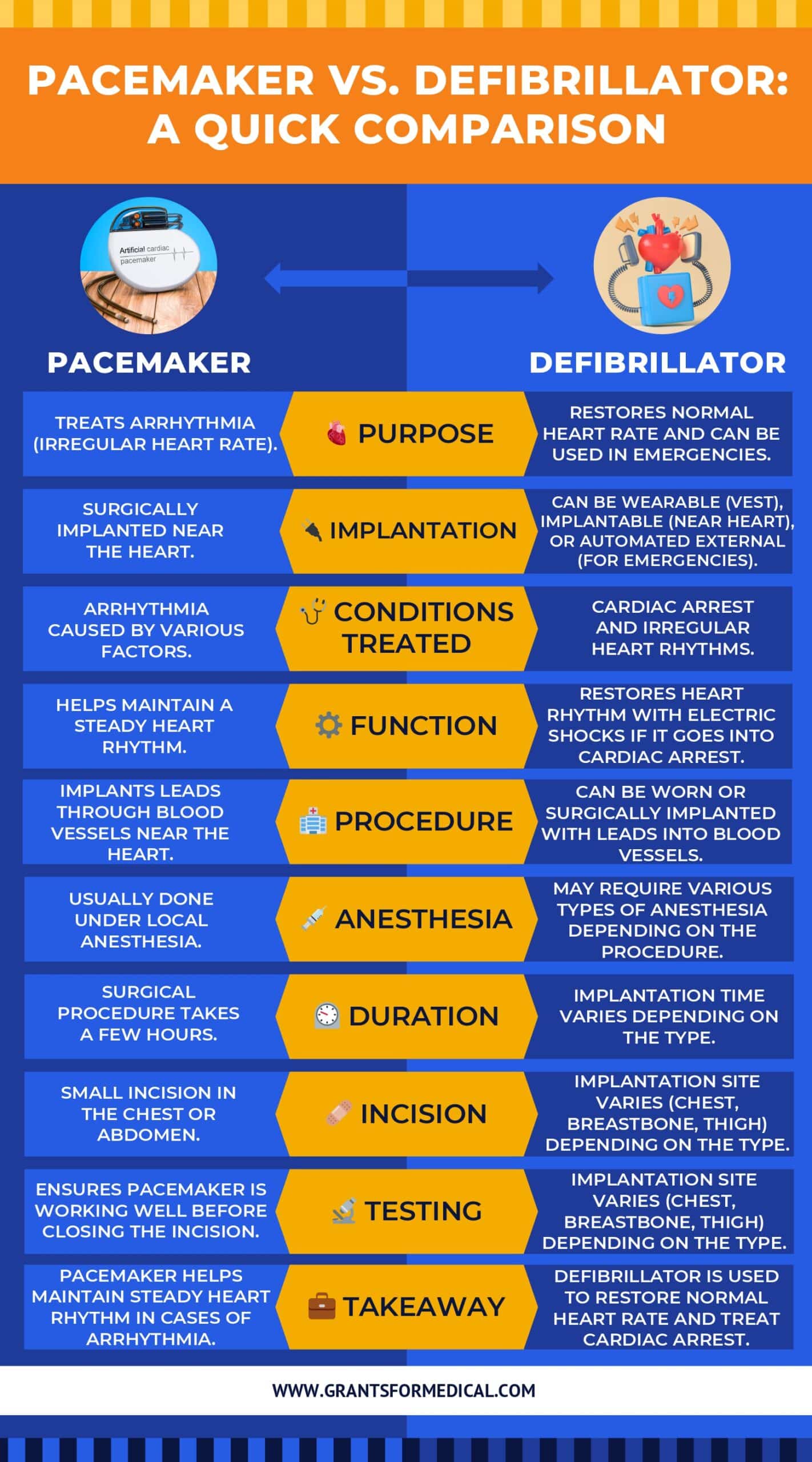Can You Have a Heart Attack with a Pacemaker?
Yes, you can have a heart attack even with a pacemaker or defibrillator installed/implanted. However, a pacemaker cannot treat cardiac arrest, but an implanted defibrillator (ICD) can treat ventricular arrhythmias that may lead to cardiac arrest.
The battery life of a pacemaker or an implanted cardioverter-defibrillator (ICD) typically ranges from 5 to 15 years, depending on the device and how often it is used. In most cases, patients lead a normal life with an ICD or pacemaker.
Technological advances have reduced the chances of machines, such as microwaves, interfering with a pacemaker’s or ICD’s functions.
Difference Between Pacemaker and Defibrillator

Many people tend to confuse pacemakers with defibrillators and vice versa. Patient education is needed so that they can know the difference between the two.
If you two get confused between the two, then this article will be helpful.
What is a Defibrillator?
A defibrillator, specifically an ICD, delivers electric shocks to restore a normal heart rhythm during life-threatening arrhythmias, not to maintain an average heart rate. They can also be used to restore the heart rate if the patient goes into cardiac arrest.
Defibrillators come in several types, which mainly include:
Wearable defibrillators – This type of defibrillator is worn on the body as a vest, under your clothes. It has sensors that remain in contact with the skin to monitor your heart rate and rhythm.
Implantable defibrillators – This type of defibrillator is surgically implanted in the chest or abdomen, with leads inserted through the veins and into the heart.
The sensor can detect an abnormal heart rate and quickly send an electric pulse to adjust the rhythm back to normal.
Automated external defibrillators – These defibrillators are used in medical emergencies if someone is experiencing a cardiac arrest.
What is a Pacemaker?
A pacemaker is a medical device that works similarly to defibrillators. It is designed to treat patients suffering from arrhythmia. This is a cardiac condition where the heart beats at an irregular rate, or frequent pauses between beats, among others.
A pacemaker primarily helps regulate the rhythm of the heart’s two lower chambers (ventricles) or one lower chamber in some cases, ensuring effective blood pumping.
Arrhythmia, which requires a pacemaker, may be caused by several different reasons, such as:
- Problems with the heart’s electrical signaling pathways
- Heart attack
- Structural problems in the heart
- Specific types of muscular dystrophy
A pacemaker is implanted by using an X-ray or similar imaging technology to thread the device’s leads through your blood vessels so they can reach the heart’s chambers.
The leads are typically inserted through a vein in the upper chest, and the device is implanted under the skin near the collarbone.
Once the leads are in place, the surgeon will make a small incision in your abdomen or chest. The pacemaker generator will be carefully placed just underneath your skin.
Once the other leads are connected to the generator, the surgeon will test to ensure the pacemaker is working well before closing the small incision with sutures.
This surgical procedure usually takes a few hours and can be done under local anesthesia.
How Effective is a Defibrillator?
Having a defibrillator installed can significantly improve your chances of survival. The 2017 study’s survival rates are misrepresented; ICDs generally improve survival over multiple years, not just 2 years.
However, researchers noted that significant medical care was required after implantation of the ICD for many participants, especially those who were older.
Another study conducted in 2020 evaluated 1,855 participants who suffered from heart failure and received a placebo or were implanted with an ICD. After around 4 years, it was found that ICD lowered the fatality rate by 23%.
The study concluded that patients with an ICD showed continued improved long-term survival even after 11 years, compared to those with a placebo.
The ICD’s most significant benefit was seen over 6 years after the implant surgery. At the end of this period, no additional survival benefits were found.
How Effective is a Pacemaker?
A pacemaker also significantly improves the patient’s outlook. For instance, a 2016 study following 1,035 patients with single—or double-lead pacemakers for 4 years concluded that the mortality rate for those installed with pacemakers was around 4.7% and 3.7%, respectively.
Another study, conducted in 2020 and evaluating 6,362 people with pacemakers, found that certain underlying health conditions can impact the effectiveness of pacemakers and outlook.
These include health conditions such as high blood pressure, higher cholesterol and triglycerides levels, heart valve disease, heart failure, coronary heart disease, previous strokes, etc.
Conclusion
Although you can suffer from a heart attack with a pacemaker or defibrillator, these devices help to restore heart functions even after a cardiac arrest.
These are genuinely life-saving devices, especially for those with health conditions that weaken the heart’s functions.
See Also
Essential Hospital Equipment List